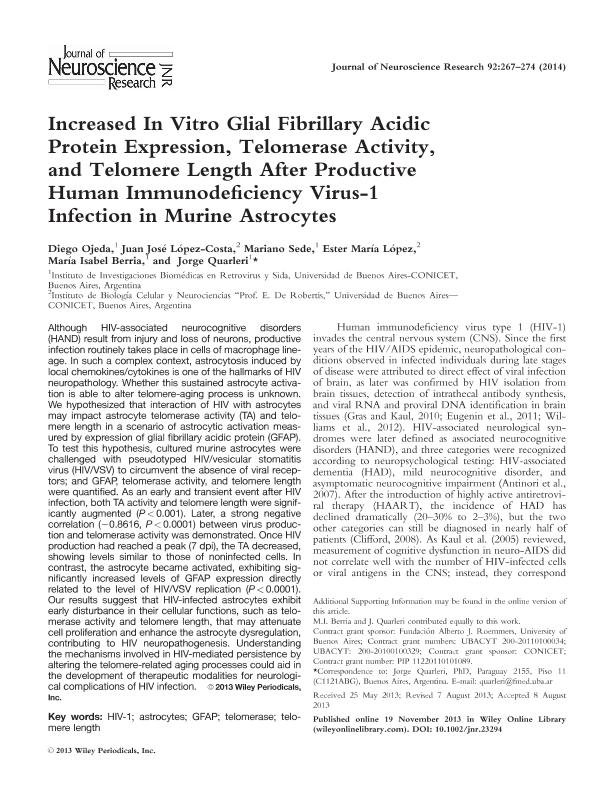Artículo
Increased in vitro glial fibrillary acidic protein expression, telomerase activity, and telomere length after productive human immunodeficiency virus-1 infection in murine astrocytes
Ojeda, Diego Sebastian ; Lopez, Juan Jose
; Lopez, Juan Jose ; Sede, Mariano Miguel
; Sede, Mariano Miguel ; Lopez, Ester Maria
; Lopez, Ester Maria ; Berria, Maria Isabel
; Berria, Maria Isabel ; Quarleri, Jorge Fabian
; Quarleri, Jorge Fabian
 ; Lopez, Juan Jose
; Lopez, Juan Jose ; Sede, Mariano Miguel
; Sede, Mariano Miguel ; Lopez, Ester Maria
; Lopez, Ester Maria ; Berria, Maria Isabel
; Berria, Maria Isabel ; Quarleri, Jorge Fabian
; Quarleri, Jorge Fabian
Fecha de publicación:
02/2014
Editorial:
Wiley
Revista:
Journal of Neuroscience Research
ISSN:
0360-4012
e-ISSN:
1097-4547
Idioma:
Inglés
Tipo de recurso:
Artículo publicado
Clasificación temática:
Resumen
Although HIV-associated neurocognitive disorders (HAND) result from injury and loss of neurons, productive infection routinely takes place in cells of macrophage lineage. In such a complex context, astrocytosis induced by local chemokines/cytokines is one of the hallmarks of HIV neuropathology. Whether this sustained astrocyte activation is able to alter telomere-aging process is unknown. We hypothesized that interaction of HIV with astrocytes may impact astrocyte telomerase activity (TA) and telomere length in a scenario of astrocytic activation measured by expression of glial fibrillary acidic protein (GFAP). To test this hypothesis, cultured murine astrocytes were challenged with pseudotyped HIV/vesicular stomatitis virus (HIV/VSV) to circumvent the absence of viral receptors; and GFAP, telomerase activity, and telomere length were quantified. As an early and transient event after HIV infection, both TA activity and telomere length were significantly augmented (P < 0.001). Later, a strong negative correlation (−0.8616, P < 0.0001) between virus production and telomerase activity was demonstrated. Once HIV production had reached a peak (7 dpi), the TA decreased, showing levels similar to those of noninfected cells. In contrast, the astrocyte became activated, exhibiting significantly increased levels of GFAP expression directly related to the level of HIV/VSV replication (P < 0.0001). Our results suggest that HIV-infected astrocytes exhibit early disturbance in their cellular functions, such as telomerase activity and telomere length, that may attenuate cell proliferation and enhance the astrocyte dysregulation, contributing to HIV neuropathogenesis. Understanding the mechanisms involved in HIV-mediated persistence by altering the telomere-related aging processes could aid in the development of therapeutic modalities for neurological complications of HIV infection.
Palabras clave:
Gfap
,
Hiv-1
,
Astrocytes
,
Telomerase
,
Telomere Length
Archivos asociados
Licencia
Identificadores
Colecciones
Articulos(IBCN)
Articulos de INST.DE BIOLO.CEL.Y NEURCS."PROF.E.DE ROBERTIS"
Articulos de INST.DE BIOLO.CEL.Y NEURCS."PROF.E.DE ROBERTIS"
Articulos(INBIRS)
Articulos de INSTITUTO DE INVESTIGACIONES BIOMEDICAS EN RETROVIRUS Y SIDA
Articulos de INSTITUTO DE INVESTIGACIONES BIOMEDICAS EN RETROVIRUS Y SIDA
Citación
Ojeda, Diego Sebastian; Lopez, Juan Jose; Sede, Mariano Miguel; Lopez, Ester Maria; Berria, Maria Isabel; et al.; Increased in vitro glial fibrillary acidic protein expression, telomerase activity, and telomere length after productive human immunodeficiency virus-1 infection in murine astrocytes; Wiley; Journal of Neuroscience Research; 92; 2; 2-2014; 267-274
Compartir
Altmétricas



